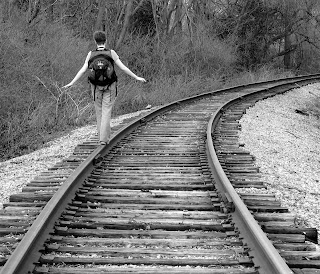Healthy Aging - Balance!
I know I have written about this
particular topic before, but it is so important I want to expand on it
some more. Healthy balance is not just
good for the elderly. It is vital for
all ages! Improving balance helps keep
us from running into things as we are much more aware of where we are in
space. It also makes falls less likely
and injuries might heal faster because less damage is done.
The Dorsal Columns are the areas of your nervous system that
control position sense. This is the system that helps you touch your
finger to your nose with your eyes closed.
The medical term for this is proprioception. You use a combination of memory and
proprioception (position sense) every time you drive your car. How else can you look ahead at the road and
still be able to find the pedals at your feet without looking?! When this part of your nervous system is weak
people have a greater problem balancing, have increased incidences of ankle
sprains, and even run into doorframes!
Balance is an important issue, especially as we age, when falls can be
deadly.
I will go over the basics like I have done
in previous articles on balance but I’ll get into more challenging exercises
for those who are ready for them!
Basic exercise: Stand next to a wall or chair where you can
reach your hand out to steady yourself if necessary. Lift one foot off the floor, balancing on the
other leg. Hold this position. Ten seconds is really good. If you can only do a couple of seconds,
that’s okay, it’s just like any other exercise and will take some time to build
up strength. If you can only do a few
seconds, try balancing several times on each leg. Try not to rest the foot you lift on the leg
you are balancing on (that’s cheating!).
Try working up to 20-30 seconds. If
you can go longer – AWESOME! This simple
exercise not only strengthens your proprioception (position sense) but also
helps strengthen your leg muscles and the gluteal (butt) muscle that supports
your hip while walking. It also
strengthens your ankles.
More Advanced: Once you feel more comfortable with the basic
exercise, try closing your eyes for a few seconds. Remember to have something nearby to help
steady you if you need it. When your
eyes are closed you are relying totally on your proprioception (position sense)
and not using visual input for help (which uses another part of your brain).
Every Day: As you are working on these specific
exercises, find ways to incorporate balance into everyday activities such as
putting on socks and shoes standing up, tying shoes standing, brush teeth
standing on one leg, etc. You can add
balance exercises to your workout routine as well. Here are some examples of what you might
try:
*If you do standing leg lifts to
work your outer thighs, try not holding onto something while you do them
(remember to have something nearby, though).
You can also bring your leg back at an angle instead of just to the side
to work more of you gluteal muscles.
*Try not to look at your feet while
performing exercises or walking (if you can do so safely). A bonus here is that this helps your
posture. For a small cheat, look at a
mirror instead of down at your feet!
*Faster isn’t always
necessary. Even I get discouraged
watching “Energizer Bunnies” work out!
Try balancing on one leg and moving your leg in a circle; the wider the
circle the greater the workout. Slow
movements help with stability and control and give a really good workout as
well.
*Make up any exercise you want that
will force you to balance. Such as
standing on one leg and raising your hands up in the air. Moving around forces your muscles to work
harder and further strengthens your proprioception. You can even try hopping on one leg (hopscotch,
anyone?).
* Yoga could be a great activity
with certain poses that work on balance.
The next levels: Once you’ve tried some of the suggestions
above and are getting better at your balance you are ready for the next
level. To the exercises above, start
adding in head movements. Try balancing
with your head turned to the right, left, looking up and looking down. You might be surprised that one position
might be much more difficult than another.
If so, THAT is the one to work on!
All of these additional challenges force the brain to get even better at
fine tuning your balance. Once you are
better at balancing on a stable surface, try (in the same order as above)
standing on a pillow to make it just a little harder.
As with any exercise, if you experience pain while
performing any of the above, please stop or try changing what you are
doing. Pain is an indicator that
something is not functioning properly.
It may indicate that your muscles and joints need some “tender loving
care” to help them function their best.
Remember that taking care of yourself now will prevent problems in the
future!
All ages benefit from balance exercises so don’t forget to
help teach a friend, loved one, or child something new to increase their
health.
It can take time to build up strength in your muscles and
your proprioception, so don’t become discouraged. I’ve used these exercises myself and continue
to teach them to my patients. We have
seen great improvements. Just as we have
to continue to exercise our muscles, the same is true for our balance.
Did you like this article? Do you have a question or topic that you
would like to have Dr. Smith cover? Please let her know! You can simply comment.



Comments
Post a Comment